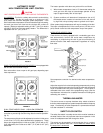
9
WARNING
FAILURE TO CORRECT BACK DRAFTS MAY CAUSE AIR
CONTAMINATION AND UNSAFE CONDITIONS.
Vent connectors serving appliances vented by natural draft shall
not be connected into any portion of mechanical draft systems
operating under positive pressure.
3. CONNECTING BOILER TO A COMMON VENT
Do not connect the boiler to a common vent or chimney with solid
fuel burning equipment. This practice is prohibited by most local
building codes as is the practice of venting gas fired equipment to
the duct work of ventilation systems.
Where a separate vent connection is not available and the vent
pipe from the boiler must be connected to a common vent with an
oil burning furnace, the vent pipe should enter the common vent or
chimney at a point ABOVE the flue pipe from the oil furnace.
UL/ULC listed doublewall type B-1 gas vents, through 24" (610
mm) diameter, can be installed in heated and unheated areas and
can pass through floors, ceilings, partitions, walls and roofs,
provided the required clearance is observed.
At the time of removal of an existing boiler, the following steps
shall be performed with each appliance remaining connected to
the common venting system. Perform these steps while the other
appliances remaining connected to the common venting system
are not in operation.
— Seal any unused openings in the common venting system.
— Visually inspect the venting system for proper size and
horizontal pitch and determine there is not blockage or
restriction, leakage, corrosion and other deficiencies which
could cause an unsafe condition.
— Insofar as is practical, close all building doors and windows
and all doors between the space in which the appliances
remaining connected to the common venting system are
located and other spaces of the building. Turn on clothes dryers
and any appliance not connected to the common venting
system. Turn on any exhaust fans, such as range hoods and
bathroom exhaust fans, so they will operate at maximum speed.
Close fireplace dampers.
— Place in operation the appliance being inspected. Follow the
lighting instructions. Adjust thermostat so appliance will
operate continuously.
— Test for spillage at the draft hood relief opening after five
minutes of main burner operation. Use the flame of a match
or candle, or smoke from a cigarette, cigar or pipe.
— After it has been determined that each appliance remaining
connected to the common venting system properly vents when
tested as outlined above, return doors, windows, exhaust fans,
fireplace dampers and any other gas burning appliance to their
previous conditions of use.
GAS CONNECTIONS
WARNING
THIS BOILER IS NOT INTENDED TO OPERATE AT GAS SUPPLY
PRESSURE OTHER THAN SHOWN ON THE RATING PLATE.
EXPOSURE TO HIGHER GAS SUPPLY PRESSURE MAY CAUSE
DAMAGE TO GAS VALVES WHICH CAN RESULT IN FIRE OR
EXPLOSION. IF OVERPRESSURE HAS OCCURRED SUCH AS
THROUGH IMPROPER TESTING OF GAS LINES OR
EMERGENCY MALFUNCTION OF THE SUPPLY SYSTEM, THE
GAS VALVES MUST BE CHECKED FOR SAFE OPERATION.
MAKE SURE THAT THE OUTSIDE VENTS ON THE SUPPLY
REGULATORS AND THE SAFETY VENT VALVES ARE
PROTECTED AGAINST BLOCKAGE. THESE ARE PARTS OF
THE GAS SUPPLY SYSTEM, NOT THE BOILER. VENT
BLOCKAGE MAY OCCUR DURING ICE BUILD-UP OR SNOW
STORMS.
WHEN LOCAL CODES REQUIRE A MAIN MANUAL SHUTOFF
VALVE OUTSIDE THE BOILER JACKET, A SUITABLE MAIN
MANUAL SHUTOFF VALVE MUST BE INSTALLED IN A
LOCATION COMPLYING WITH THOSE CODES.
IT IS IMPORTANT TO GUARD AGAINST GAS VALVE FOULING
FROM CONTAMINANTS IN THE GAS WAYS. SUCH FOULING
MAY CAUSE IMPROPER OPERATION, FIRE OR EXPLOSION.
IF COPPER SUPPLY LINES ARE USED THEY MUST BE
APPROVED FOR GAS SERVICE.
BEFORE ATTACHING THE GAS LINE BE SURE THAT ALL GAS
PIPE IS CLEAN ON THE INSIDE.
TO TRAP ANY DIRT OR FOREIGN MATERIAL IN THE GAS
SUPPLY LINE, A DIRT LEG (SOMETIMES CALLED DRIP LEG
OR SEDIMENT TRAP) UPSTREAM OF THE GAS CONTROLS,
MUST BE INCORPORATED IN THE PIPING. The dirt leg must be
readily accessible and not subject to freezing conditions. INSTALL
IN ACCORDANCE WITH RECOMMENDATIONS OF SERVING
GAS SUPPLIERS. REFER TO
NATIONAL FUEL GAS CODE, ANSI
Z223.1 AND/OR CAN/CSA-B149.1-00.
To prevent damage, care must be taken not to apply too much
torque when attaching gas supply pipe to gas valve gas inlet.
Fittings and unions in the gas line must be metal to metal type.
Apply joint compounds (pipe dope) sparingly and only to the male
threads of pipe joints. Do not apply compound to the first two
threads. Use compounds resistant to the action of liquefied
petroleum gases.
The boiler and its individual shutoff valve must be disconnected
from the gas supply piping system during any pressure testing of
that system at test pressures in excess of 1/2 psi (3.5 kPa).
The boiler must be isolated from the gas supply piping system by
closing its individual manual shutoff valve during any pressure
testing of the gas supply piping systems at test pressures equal to
or less than 1/2 psi (3.5 kPa).
The boiler and its gas connection must be leak tested before placing
the boiler in operation.
Provisions for vent, bleed and gas relief lines (when applicable).


















